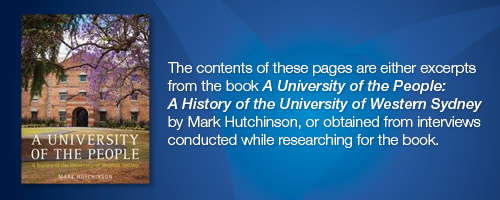- Official Launch Livestream
- The History of UWS
- Your Stories
-
People
- - Miriam Mikol, Key Administrator
- - James W. Guthrie, Network University Mentor
- - John Aquilina, Politician and Protector
- - Owen Carter, Transitioneer
- - Ralph W. Rawlinson, Planner
- - Brian Smith, Founding Vice-Chancellor
- - Ian Turbott, Foundation Chancellor
- - John M. Ward, inaugurating Acting Vice-Chancellor
- - Betty M. Andersen, Innovative Nursing Educator
- - Ronald E. Parry, On Her Majesty's Public Service
- Places
- Milestones
- 25 years in 25 weeks
People

Long before it ever became the object of legislation, a university in Western Sydney was the object of community desire. In 1953, Gough Whitlam referred to the lack of educational opportunity (or indeed, many of the more basic services, such as roads and sewerage) in his south-western Sydney seat of Werriwa. Schools, hospitals and educational opportunity would be his familiar refrain right up until the eve of his election, in 1972, when he promised that "The next university in NSW, the next college of advanced education and the next teachers' college must be built in the western suburbs, an area which has the largest population of college age of any area in Australia."
In 1961, the Cumberland County Council noted the need for a university in Western Sydney for 'future students', but preferred a greenfields site at North Ryde in order to deal with the immediate pressure of students from the northern suburbs which threatened to turn the University of New South Wales and the University of Sydney into 'vast unwieldy organisations'. The allocation of space for universities at Werrington and in Campbelltown would remain an accusing green finger for another three decades.
On his accession as Prime Minister in 1972, Gough Whitlam commissioned what would become the Bull-Swanson Report (1973), which acted as the basis for declarations by the Commonwealth Minister for Education in 1974 that a new university would be established in Campbelltown. Unfortunately, the dismissal of the Whitlam government the next year, the instability of New South Wales government with the resignation of Sir Robert Askin, and need for restraint in public spending in every government which followed, meant that succeeding federal governments were not inclined to fund, and state governments not inclined to enact something as hugely expensive as a new university. Reports by working parties of the Commonwealth Tertiary Education Commission, however, indicated the 'gross underprovision' of higher educational opportunity in the West, requiring the Hawke government, which was committed to greater social equity, to do something.
In the meantime, the Higher Education Board in New South Wales was slowly developing a plan to 'bootstrap' at least one of Western Sydney's Colleges of Advanced Education (CAE) into a university in stages. When the (Labor) federal Education Minister (Susan Ryan) approached the New South Wales (Labor) government of Neville Wran about establishing further technical education in the West, Wran seized the issue as one of state’s rights and as a major project that would demonstrate Labor's commitment to the West. Another technical college would not suffice -- the state would convene an enquiry and then act on the results by legislating for a new University of the West.
Whereas Gough Whitlam had had the money, but not the legislative power to establish a university in NSW, Neville Wran had the legislative power but no untied access to federal funding. The Parry Report of 1985 (named after the committee's chair and head of the Higher Education Board, R. E. Parry) repeated CTEC's observations about Western Sydney’s underprivileged, and proposed that merging two of the existing CAEs in the West would provide a cost-effective way of dealing with the impasse.
Along the way, both the state and federal governments gained an understanding of just how passionate and organised the residents of Western Sydney were about providing their children with opportunities for higher education. The wrangling between State and Commonwealth delayed the project for another three years, but eventually the University of Western Sydney achieved legislative form in November 1988, coming into effective existence on 1 January 1989. These pages provide an insight into some of the people, places and events which helped give birth to what one protagonist called 'Australia's first major enterprise in higher education in the 21st century.'
Mobile options:
